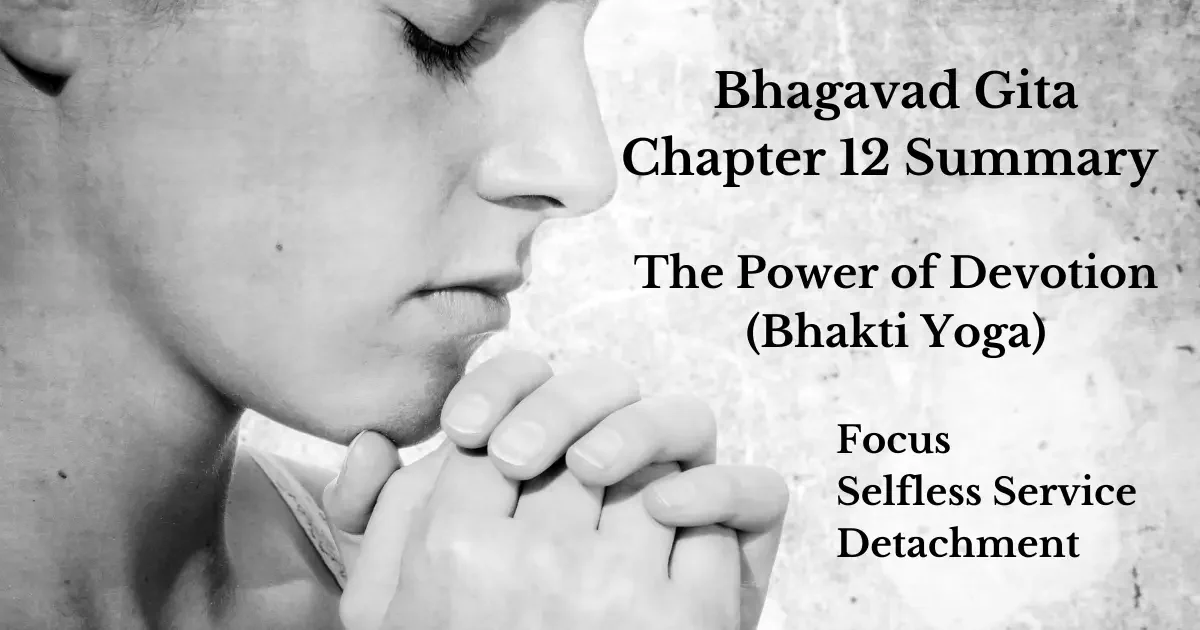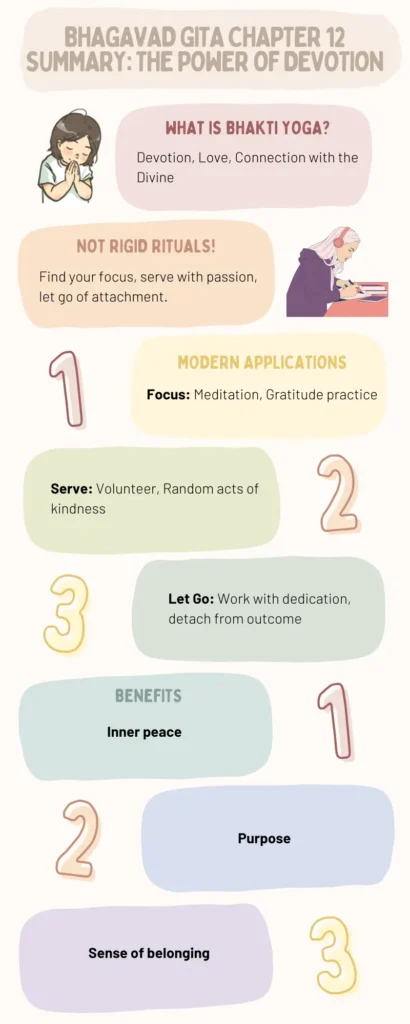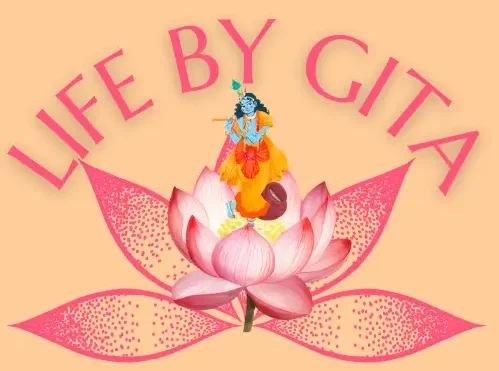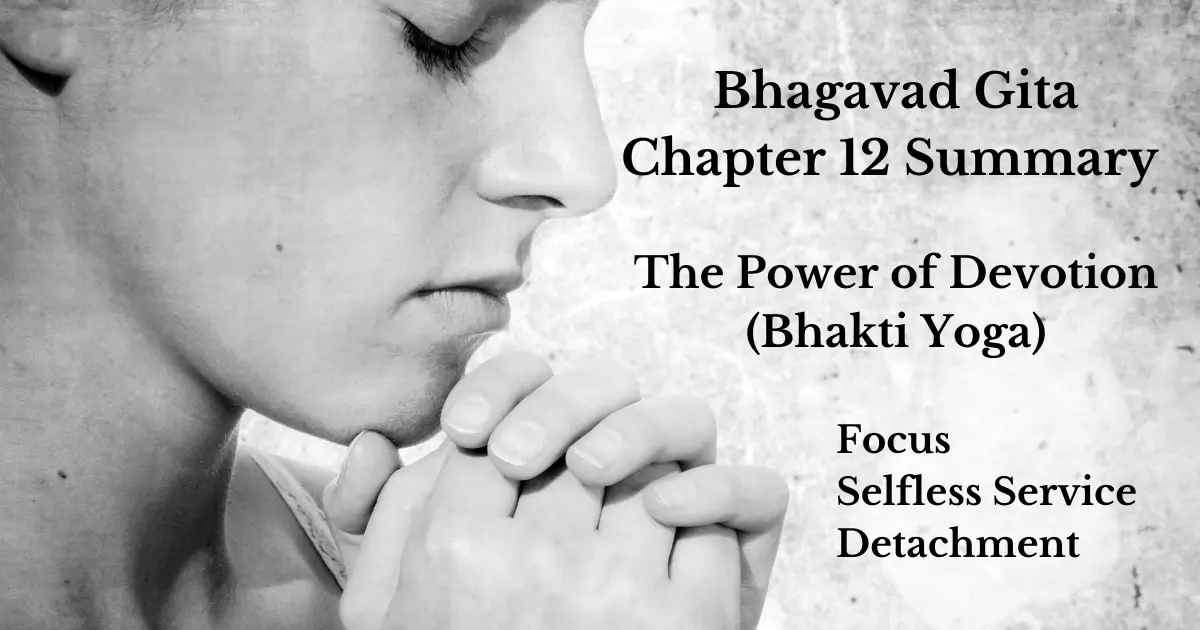
We’re back in the chariot with Arjuna and Krishna, the dynamic duo of the Bhagavad Gita! Now, we are going to discover the Power of Devotion in Chapter 12 of the Bhagavad Gita by summarizing it.
1. Introduction
In Chapter 11, Krishna unlocked the magnificent Vishwarupa – the cosmic form, leaving Arjuna overwhelmed. Now, reeling from this experience, Arjuna has a new question: which path to liberation is superior?
Chapter 12 dives deep into the beautiful world of Bhakti Yoga, the Yoga of Devotion. Get ready to explore the different ways to connect with the divine, and how it can be a powerful tool to navigate the complexities of modern life!
2. Discovering the Two Paths: Formless vs. Form
Arjuna, ever the curious warrior, asks Krishna, “Who is the greater devotee or Yogi? The one who worships your magnificent form, or the one who meditates on the formless Brahman (ultimate reality which holds everything)?”
Krishna, with his characteristic wisdom, assures Arjuna that both paths are valid. Here are powerful verses that beautifully captures this essence:
Krishna says: “The best yogis (people following a spiritual path) are those who totally focus on me and keep showing their devotion through constant prayer and unwavering belief.” (Verse 12.2)
“There are also people who focus on a bigger picture, like an amazing, unseen force that’s everywhere and can’t be described, the Formless Brahman. They control their senses and stay calm no matter what happens. They even try to help everyone they can. These folks are also on the right track and can reach me eventually.” (Verse 12.3-4)
These verses, though set in the context of war, resonate deeply in our modern lives. We all grapple with distractions, a constant mental chatter. Here, Arjuna is asking how to focus his mind on the divine, just like we might ask how to focus on our goals amidst the daily chaos.
Krishna doesn’t advocate for one path over the other. He acknowledges that some are naturally drawn to the formless, the all-encompassing Brahman, while others find solace in a personal form like Krishna himself. The key lies in the depth and sincerity of your devotion.
But, Krishna also said in the Verse 12.5 that it is difficult for the embodied beings to worship the Formless Brahman due to various problems in the path of realization.
3. Bhagavad Gita Chapter 12 Summary: The Power of Devotion
3.1 Dedicated Action & Liberation: Krishna’s Promise
The most important verses of this chapter are verse 12.6-7:
“Some people dedicate everything they do to me, like playing a sport for their favorite team. They see me as the ultimate goal and spend their time worshipping and meditating on me with total focus. Arjuna (Parth), for these people, I’m like a lifeguard who quickly pulls them out of the never-ending cycle of being born and dying, because their minds are totally connected to me.”

Here’s another one:
“Focus all your thoughts on me and trust me completely. Then, you’ll always be connected to me, there’s no question about it.“ (Verse 12.8)
This verse transcends religious boundaries. Isn’t serving a cause greater than yourself a powerful way to find meaning and purpose?
Krishna is giving Arjuna advice on how to connect with him in the Verse 12.9,10,11. It goes like this:
- Ideally, focus all your thoughts on me (Krishna). This is the best way.
- If that’s hard, try remembering me often and avoid getting distracted by worldly stuff.
- Even if focusing is tough, you can still serve me through your actions. Doing things out of devotion is a great path.
- The absolute last option is to simply do your work without worrying about the outcome.
The key message is that there are different ways to connect with the divine, and even small efforts can lead to a deeper connection.
Bhakti Yoga isn’t about rigid rituals or seeking favors. It’s about cultivating a loving connection with the divine, a source of strength and solace that transcends the limitations of our ego.
4. Modern Applications of Bhakti Yoga
We can apply the key teachings of Bhakti Yoga by the following 3 steps:
- Find Your Focus: In today’s world of constant distractions, Bhakti Yoga reminds us of the importance of focus. Whether it’s dedicating time to prayer or meditation, or simply setting aside some moments each day to express gratitude, focusing your attention on something bigger than yourself can bring immense peace.
- Serve with Passion: Bhakti Yoga encourages selfless service. Can’t dedicate hours to volunteering? Even small acts of kindness, done with a spirit of devotion, can be a powerful form of Bhakti. Helping a neighbor, offering a genuine compliment, or simply doing your work with dedication – all these can be expressions of Bhakti.
- Let Go of Attachment: The final option Krishna presents is to focus on the action itself, without getting attached to the outcome. This can be incredibly liberating in our achievement-oriented world. When we work with dedication but let go of the need for a specific result, we experience a sense of inner peace and freedom. This doesn’t mean that you should not have any goal in your life. Rather, it should be done with positive mindset again and again until the goal is achieved, without getting despaired from the negative output if any failure is there. But some work should be done without attachment to the result simply for others which will give us the inner peace and satisfaction.

5. Conclusion: The Power of Devotion in Modern Life
We’ve taken a whirlwind ride through Chapter 12 of the Bhagavad Gita, exploring the beautiful world of Bhakti Yoga, the Yoga of Devotion. We can apply its key teachings of Focusing, Serving with passion and Let go of attachment in our life. Basically, it summarizes the key teaching of the whole Bhagavad Gita as, Focus on your work, Dedicate your work to the Divine and Let go of attachment. This is what, Lord Krishna wants to say in the whole Bhagavad Gita, which is the baseline of it. “Do your Duty without attachment to its fruits (result)“. If people grasp this key teaching efficiently then definitely there will be remarkable changes seen in their life. Remember, Arjuna, the warrior, is grappling with the complexities of life, just like us in the modern world. If you are feeling lost in the daily grind and struggling to find meaning, then Bhakti Yoga offers a powerful tool.
Here’s the key takeaway: Bhakti Yoga isn’t about rigid rituals or achieving some distant goal. It’s about cultivating a loving connection with the divine, a source of strength and solace that transcends the limitations of our ego. It encourages us to connect with the bigger existence than ourselves, a source of love and guidance. Whether it’s through service, selfless acts, or simply cultivating gratitude, Bhakti Yoga fosters inner peace and resilience – qualities we all need in today’s fast-paced world.
Must Read: Feeling Stuck? The Bhagavad Gita Has the Chill Pill You Need -Chapter 3 Summary
If you want to read this summary offline, then you can download the pdf version below:
Bhagavad Gita Chapter 12 Summary pdf
6. FAQs
Q. Is Bhakti Yoga just for Hindus?
No, the core principles of Bhakti – devotion, love, and surrender – resonate with people across faiths and backgrounds.
Q. Do I need to follow rituals to practice Bhakti?
Rituals can be a beautiful way to express devotion, but Bhakti is ultimately about cultivating a loving connection with the divine in your own unique way.
Remember, the Bhagavad Gita offers a vast ocean of wisdom. This is just a glimpse into the beauty of Bhakti Yoga. So, keep exploring, keep questioning, and most importantly, keep practicing devotion in your own way.
If you have any comment or question, feel free to leave in the comment section at the bottom.
Further Reading
Holy Bhagavad Gita

